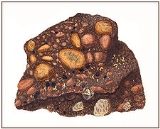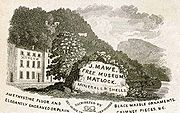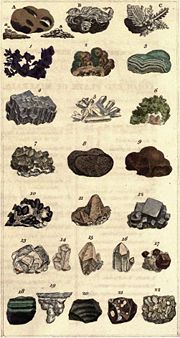
John Mawe
Encyclopedia
John Mawe was a British
mineralogist
who became well known for his practical approach to the discipline.
in 1764 to Samuel Maw(e). His mother died when he was ten and he was raised by his father's second wife, Francis (born Beigton). In early life he appears to have spent fifteen years at sea. In 1790, he became captain of the merchant vessel Trent, trading to St Petersburg.
In 1793, Mawe was apprenticed to the Derby
mason Richard Brown (1736–1816), and married his daughter, Sarah, on 1 November 1794. Brown & Mawe was the name of the retail business near Covent Garden in 1797 which sold objects created from Derbyshire marble at the factory in Derby. Mawe was manager of this business. This business was established in 1794. Geological diagrams of Derbyshire strata which are made from Derbyshire minerals were once thought to have all been created by White Watson
but it is now thought likely that some of these objects in Derby Museum
were actually created by Mawe & Brown.
About the end of the century he made a tour of most of the mines in England and Scotland, collecting minerals for the cabinet of the king of Spain. In 1800 he owned the Royal Museums spar shop in Matlock Bath
which, through his agent, he was to enter into dispute with Thomas Pearson concerning surrounding mines.
In August 1804 he started on a "voyage of commercial experiment" to Rio de la Plata
funded by Portugal's Prince Regent. His missions was to assess the value of the gold and diamond industries that might revitalize Brazil's ailing economy. Mawe had reached Cadiz
when war broke out between England and Spain, and he was blockaded in the town where he was taken ill and nearly died. He sailed from Cadiz in March 1805 for Montevideo
, and on reaching that town was imprisoned as an English spy. He procured his liberty soon after, but was interned, and did not obtain his release till the capture of Montevideo by William Beresford
in 1806. He accompanied the expedition under John Whitelocke
to Buenos Aires
, and on his return to Montevideo purchased a schooner
and sailed to Brazil
, putting in at various ports on the way, including the island of Santa Catarina
. He was well received in Brazil by the prince regent, who gave him permission to visit the diamond mines of Minas Geraes and other parts of the interior during 1809–10, and also granted him access to the government archives.
 Mawe returned to London in 1811, and opening a shop in The Strand
Mawe returned to London in 1811, and opening a shop in The Strand
, close to Somerset House
, became well known as a practical mineralogist. In 1813 he was elected to the Royal Geological Society of Cornwall
, and in 1817 he received the diploma of the Jena Mineralogischen Gesellschaft.
John and Sarah Mawe had two children, a son and a daughter. Their son, John Saint Mawe (1797–1820), died aged 22; Sarah requested in her will that she be buried beside him. Their daughter married Anthony Tissington Tatlow (1789–1828), who became a partner of Mawe's in a shop in Cheltenham
in 1816.
Mawe died in London on 26 October 1829. A tablet to his memory is in Castleton church, Derbyshire. His business was carried on by James Tennant the mineralogist, in partnership with Mawe's widow Sarah until 1840. Sarah Mawe had the title of "Mineralogist to Her Majesty" until she retired.
 Mawe's principal work was the account of his South American voyage, Travels in the Interior of Brazil, London, 1812; Philadelphia, 1816; 2nd edition, 1823.
Mawe's principal work was the account of his South American voyage, Travels in the Interior of Brazil, London, 1812; Philadelphia, 1816; 2nd edition, 1823.
He also wrote:
He edited the 2nd edit. of Wodarch's Introduction to Conchology, 1822, and wrote a paper on The Occurrence of Diamonds, &c., in Brazil for Gilbert's
Annalen
lix. (1818), besides one On the Tourmaline and Apatite of Devonshire for the Quart. Journ. of Science, iv. (1818). He appears also to have issued at some time Directions to Captains of Ships, Officers, and Travellers; particularly to those engaged in the South Sea Fishery (for collecting shells). A manuscript paper On a Gold Mine in South America is preserved in the library of the Geological Society
.
A number of Mawe's publications were extensively illustrated by James Sowerby
and his sons, who specialised in detailed colour plates.
British people
The British are citizens of the United Kingdom, of the Isle of Man, any of the Channel Islands, or of any of the British overseas territories, and their descendants...
mineralogist
Mineralogy
Mineralogy is the study of chemistry, crystal structure, and physical properties of minerals. Specific studies within mineralogy include the processes of mineral origin and formation, classification of minerals, their geographical distribution, as well as their utilization.-History:Early writing...
who became well known for his practical approach to the discipline.
Biography
Mawe was born in DerbyDerby
Derby , is a city and unitary authority in the East Midlands region of England. It lies upon the banks of the River Derwent and is located in the south of the ceremonial county of Derbyshire. In the 2001 census, the population of the city was 233,700, whilst that of the Derby Urban Area was 229,407...
in 1764 to Samuel Maw(e). His mother died when he was ten and he was raised by his father's second wife, Francis (born Beigton). In early life he appears to have spent fifteen years at sea. In 1790, he became captain of the merchant vessel Trent, trading to St Petersburg.
In 1793, Mawe was apprenticed to the Derby
Derby
Derby , is a city and unitary authority in the East Midlands region of England. It lies upon the banks of the River Derwent and is located in the south of the ceremonial county of Derbyshire. In the 2001 census, the population of the city was 233,700, whilst that of the Derby Urban Area was 229,407...
mason Richard Brown (1736–1816), and married his daughter, Sarah, on 1 November 1794. Brown & Mawe was the name of the retail business near Covent Garden in 1797 which sold objects created from Derbyshire marble at the factory in Derby. Mawe was manager of this business. This business was established in 1794. Geological diagrams of Derbyshire strata which are made from Derbyshire minerals were once thought to have all been created by White Watson
White Watson
White Watson was an early English geologist, sculptor, stonemason and carver, marble-worker and mineral dealer. In common with many learned people of his time, he was skilled in a number of artistic and scientific areas, becoming a writer, poet, journalist, teacher, botanist and gardener as well...
but it is now thought likely that some of these objects in Derby Museum
Derby Museum
Derby Museum may refer to:*Derby Museum and Art Gallery, Art gallery and museum in Derby, England*Kentucky Derby Museum*World Museum Liverpool...
were actually created by Mawe & Brown.
About the end of the century he made a tour of most of the mines in England and Scotland, collecting minerals for the cabinet of the king of Spain. In 1800 he owned the Royal Museums spar shop in Matlock Bath
Matlock Bath
Matlock Bath is a village south of Matlock in Derbyshire, England. Built along the River Derwent, it developed, in the 19th century, as a spa town and still thrives on tourism.-History:In 1698 warm springs were discovered and a Bath House was built...
which, through his agent, he was to enter into dispute with Thomas Pearson concerning surrounding mines.
In August 1804 he started on a "voyage of commercial experiment" to Rio de la Plata
Río de la Plata
The Río de la Plata —sometimes rendered River Plate in British English and the Commonwealth, and occasionally rendered [La] Plata River in other English-speaking countries—is the river and estuary formed by the confluence of the Uruguay River and the Paraná River on the border between Argentina and...
funded by Portugal's Prince Regent. His missions was to assess the value of the gold and diamond industries that might revitalize Brazil's ailing economy. Mawe had reached Cadiz
Cádiz
Cadiz is a city and port in southwestern Spain. It is the capital of the homonymous province, one of eight which make up the autonomous community of Andalusia....
when war broke out between England and Spain, and he was blockaded in the town where he was taken ill and nearly died. He sailed from Cadiz in March 1805 for Montevideo
Montevideo
Montevideo is the largest city, the capital, and the chief port of Uruguay. The settlement was established in 1726 by Bruno Mauricio de Zabala, as a strategic move amidst a Spanish-Portuguese dispute over the platine region, and as a counter to the Portuguese colony at Colonia del Sacramento...
, and on reaching that town was imprisoned as an English spy. He procured his liberty soon after, but was interned, and did not obtain his release till the capture of Montevideo by William Beresford
William Beresford, 1st Viscount Beresford
General William Carr Beresford, 1st Viscount Beresford, 1st Marquis of Campo Maior, GCB, GCH, GCTE, PC , was a British soldier and politician...
in 1806. He accompanied the expedition under John Whitelocke
John Whitelocke
-Military career:Whitelocke entered the army in 1778 and served in Jamaica and in San Domingo. In 1805 he was made a lieutenant-general and inspector-general of recruiting, and in 1807 he was appointed to command an expedition to seize Buenos Aires from the Spanish Empire, which was in disarray due...
to Buenos Aires
Buenos Aires
Buenos Aires is the capital and largest city of Argentina, and the second-largest metropolitan area in South America, after São Paulo. It is located on the western shore of the estuary of the Río de la Plata, on the southeastern coast of the South American continent...
, and on his return to Montevideo purchased a schooner
Schooner
A schooner is a type of sailing vessel characterized by the use of fore-and-aft sails on two or more masts with the forward mast being no taller than the rear masts....
and sailed to Brazil
Brazil
Brazil , officially the Federative Republic of Brazil , is the largest country in South America. It is the world's fifth largest country, both by geographical area and by population with over 192 million people...
, putting in at various ports on the way, including the island of Santa Catarina
Santa Catarina (island)
Florianópolis Island is an island in the Brazilian state of Santa Catarina. It is located on the south coast of Brazil between the south 27° latitude and west 48° longitude...
. He was well received in Brazil by the prince regent, who gave him permission to visit the diamond mines of Minas Geraes and other parts of the interior during 1809–10, and also granted him access to the government archives.

Strand, London
Strand is a street in the City of Westminster, London, England. The street is just over three-quarters of a mile long. It currently starts at Trafalgar Square and runs east to join Fleet Street at Temple Bar, which marks the boundary of the City of London at this point, though its historical length...
, close to Somerset House
Somerset House
Somerset House is a large building situated on the south side of the Strand in central London, England, overlooking the River Thames, just east of Waterloo Bridge. The central block of the Neoclassical building, the outstanding project of the architect Sir William Chambers, dates from 1776–96. It...
, became well known as a practical mineralogist. In 1813 he was elected to the Royal Geological Society of Cornwall
Royal Geological Society of Cornwall
The Royal Geological Society of Cornwall is a geological society based in Cornwall in the United Kingdom. It was founded in 1814 to promote the study of the geology of Cornwall, and is the second oldest geological society in the world....
, and in 1817 he received the diploma of the Jena Mineralogischen Gesellschaft.
John and Sarah Mawe had two children, a son and a daughter. Their son, John Saint Mawe (1797–1820), died aged 22; Sarah requested in her will that she be buried beside him. Their daughter married Anthony Tissington Tatlow (1789–1828), who became a partner of Mawe's in a shop in Cheltenham
Cheltenham
Cheltenham , also known as Cheltenham Spa, is a large spa town and borough in Gloucestershire, on the edge of the Cotswolds in the South-West region of England. It is the home of the flagship race of British steeplechase horse racing, the Gold Cup, the main event of the Cheltenham Festival held...
in 1816.
Mawe died in London on 26 October 1829. A tablet to his memory is in Castleton church, Derbyshire. His business was carried on by James Tennant the mineralogist, in partnership with Mawe's widow Sarah until 1840. Sarah Mawe had the title of "Mineralogist to Her Majesty" until she retired.
Works

He also wrote:
- 1. The Mineralogy of Derbyshire, 1802.
- 2. A Treatise on Diamonds and Precious Stones, 1813; 2nd ed. 1823.
- 3. A Catalogue of Minerals, 1815.
- 4. A Descriptive Catalogue of Minerals, 1816; 4th edit. 1821; reissued in 1823.
- 5. Familiar Lessons on Mineralogy and Geology, 1819; 10th edit. 1828.
- 6. Amateur Lapidary's Guide, 3rd edit. 1823; 1827.
- 7. Instructions for the use of the Blow-pipe and Chemical Tests, 4th edit. 1825.
- 8. The Voyager's Companion or Shell-Collector's Pilot, 1821; 4th edit. 1825.
- 9. The Linnæan System of Conchology, 1823.
He edited the 2nd edit. of Wodarch's Introduction to Conchology, 1822, and wrote a paper on The Occurrence of Diamonds, &c., in Brazil for Gilbert's
Ludwig Wilhelm Gilbert
Ludwig Wilhelm Gilbert was a German physicist and chemist, and professor of physics at the University of Leipzig. From 1799-1824 he published the "Annalen der Physik", of which Poggendorffs "Annalen der Physik und Chemie" was a continuation.-Biography:Gilbert was born in Berlin...
Annalen
Annalen der Physik
Annalen der Physik is one of the oldest physics journals worldwide. The journal publishes original, peer-reviewed papers in the areas of experimental, theoretical, applied and mathematical physics and related areas...
lix. (1818), besides one On the Tourmaline and Apatite of Devonshire for the Quart. Journ. of Science, iv. (1818). He appears also to have issued at some time Directions to Captains of Ships, Officers, and Travellers; particularly to those engaged in the South Sea Fishery (for collecting shells). A manuscript paper On a Gold Mine in South America is preserved in the library of the Geological Society
Geological Society of London
The Geological Society of London is a learned society based in the United Kingdom with the aim of "investigating the mineral structure of the Earth"...
.
A number of Mawe's publications were extensively illustrated by James Sowerby
James Sowerby
James Sowerby was an English naturalist and illustrator. Contributions to published works, such as A Specimen of the Botany of New Holland or English Botany, include his detailed and appealing plates...
and his sons, who specialised in detailed colour plates.

